transmission CHEVROLET AVALANCHE 2007 2.G Owners Manual
[x] Cancel search | Manufacturer: CHEVROLET, Model Year: 2007, Model line: AVALANCHE, Model: CHEVROLET AVALANCHE 2007 2.GPages: 618, PDF Size: 3.25 MB
Page 91 of 618
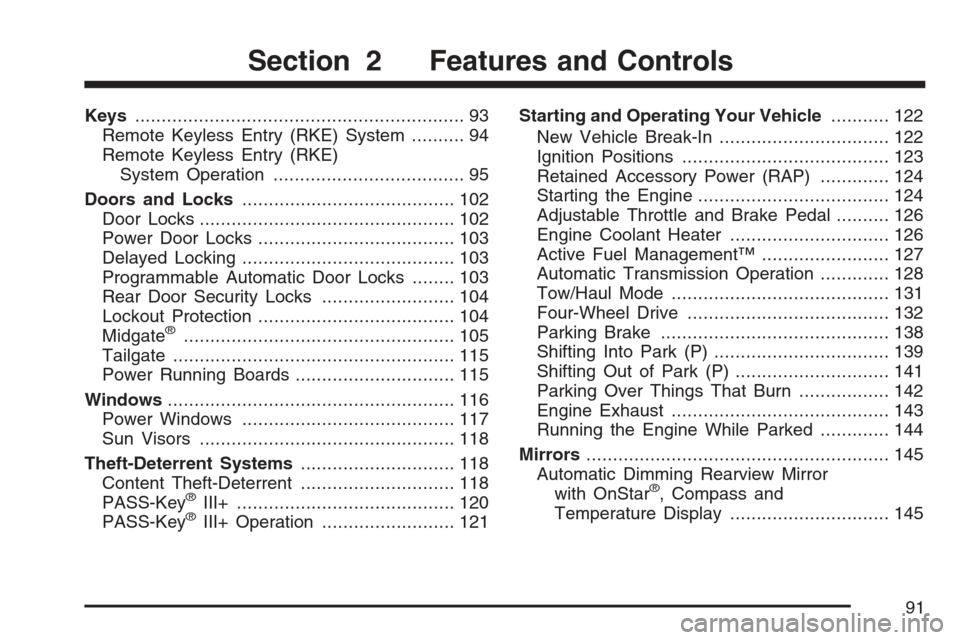
Keys.............................................................. 93
Remote Keyless Entry (RKE) System.......... 94
Remote Keyless Entry (RKE)
System Operation.................................... 95
Doors and Locks........................................ 102
Door Locks................................................ 102
Power Door Locks..................................... 103
Delayed Locking........................................ 103
Programmable Automatic Door Locks........ 103
Rear Door Security Locks......................... 104
Lockout Protection..................................... 104
Midgate
®................................................... 105
Tailgate..................................................... 115
Power Running Boards.............................. 115
Windows...................................................... 116
Power Windows........................................ 117
Sun Visors................................................ 118
Theft-Deterrent Systems............................. 118
Content Theft-Deterrent............................. 118
PASS-Key
®III+......................................... 120
PASS-Key®III+ Operation......................... 121Starting and Operating Your Vehicle........... 122
New Vehicle Break-In................................ 122
Ignition Positions....................................... 123
Retained Accessory Power (RAP)............. 124
Starting the Engine.................................... 124
Adjustable Throttle and Brake Pedal.......... 126
Engine Coolant Heater.............................. 126
Active Fuel Management™........................ 127
Automatic Transmission Operation............. 128
Tow/Haul Mode......................................... 131
Four-Wheel Drive...................................... 132
Parking Brake........................................... 138
Shifting Into Park (P) ................................. 139
Shifting Out of Park (P)............................. 141
Parking Over Things That Burn................. 142
Engine Exhaust......................................... 143
Running the Engine While Parked............. 144
Mirrors......................................................... 145
Automatic Dimming Rearview Mirror
with OnStar
®, Compass and
Temperature Display.............................. 145
Section 2 Features and Controls
91
Page 123 of 618
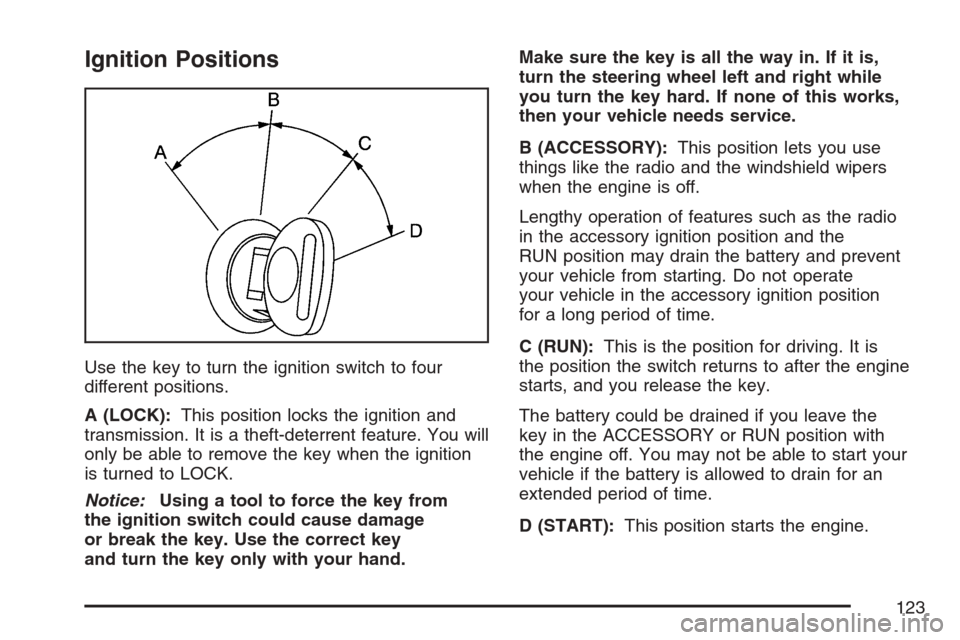
Ignition Positions
Use the key to turn the ignition switch to four
different positions.
A (LOCK):This position locks the ignition and
transmission. It is a theft-deterrent feature. You will
only be able to remove the key when the ignition
is turned to LOCK.
Notice:Using a tool to force the key from
the ignition switch could cause damage
or break the key. Use the correct key
and turn the key only with your hand.Make sure the key is all the way in. If it is,
turn the steering wheel left and right while
you turn the key hard. If none of this works,
then your vehicle needs service.
B (ACCESSORY):This position lets you use
things like the radio and the windshield wipers
when the engine is off.
Lengthy operation of features such as the radio
in the accessory ignition position and the
RUN position may drain the battery and prevent
your vehicle from starting. Do not operate
your vehicle in the accessory ignition position
for a long period of time.
C (RUN):This is the position for driving. It is
the position the switch returns to after the engine
starts, and you release the key.
The battery could be drained if you leave the
key in the ACCESSORY or RUN position with
the engine off. You may not be able to start your
vehicle if the battery is allowed to drain for an
extended period of time.
D (START):This position starts the engine.
123
Page 124 of 618
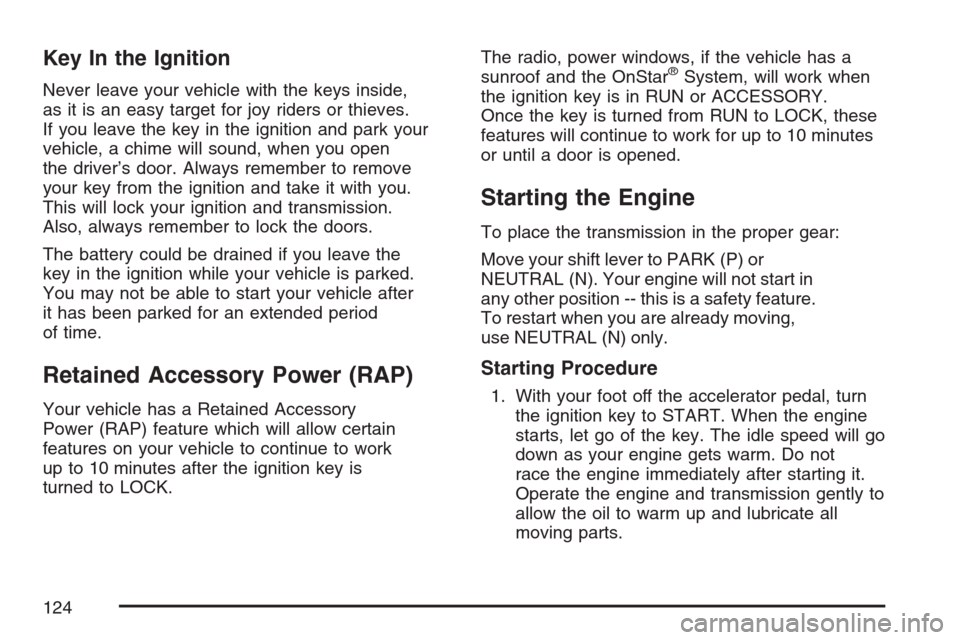
Key In the Ignition
Never leave your vehicle with the keys inside,
as it is an easy target for joy riders or thieves.
If you leave the key in the ignition and park your
vehicle, a chime will sound, when you open
the driver’s door. Always remember to remove
your key from the ignition and take it with you.
This will lock your ignition and transmission.
Also, always remember to lock the doors.
The battery could be drained if you leave the
key in the ignition while your vehicle is parked.
You may not be able to start your vehicle after
it has been parked for an extended period
of time.
Retained Accessory Power (RAP)
Your vehicle has a Retained Accessory
Power (RAP) feature which will allow certain
features on your vehicle to continue to work
up to 10 minutes after the ignition key is
turned to LOCK.The radio, power windows, if the vehicle has a
sunroof and the OnStar
®System, will work when
the ignition key is in RUN or ACCESSORY.
Once the key is turned from RUN to LOCK, these
features will continue to work for up to 10 minutes
or until a door is opened.
Starting the Engine
To place the transmission in the proper gear:
Move your shift lever to PARK (P) or
NEUTRAL (N). Your engine will not start in
any other position -- this is a safety feature.
To restart when you are already moving,
use NEUTRAL (N) only.
Starting Procedure
1. With your foot off the accelerator pedal, turn
the ignition key to START. When the engine
starts, let go of the key. The idle speed will go
down as your engine gets warm. Do not
race the engine immediately after starting it.
Operate the engine and transmission gently to
allow the oil to warm up and lubricate all
moving parts.
124
Page 125 of 618
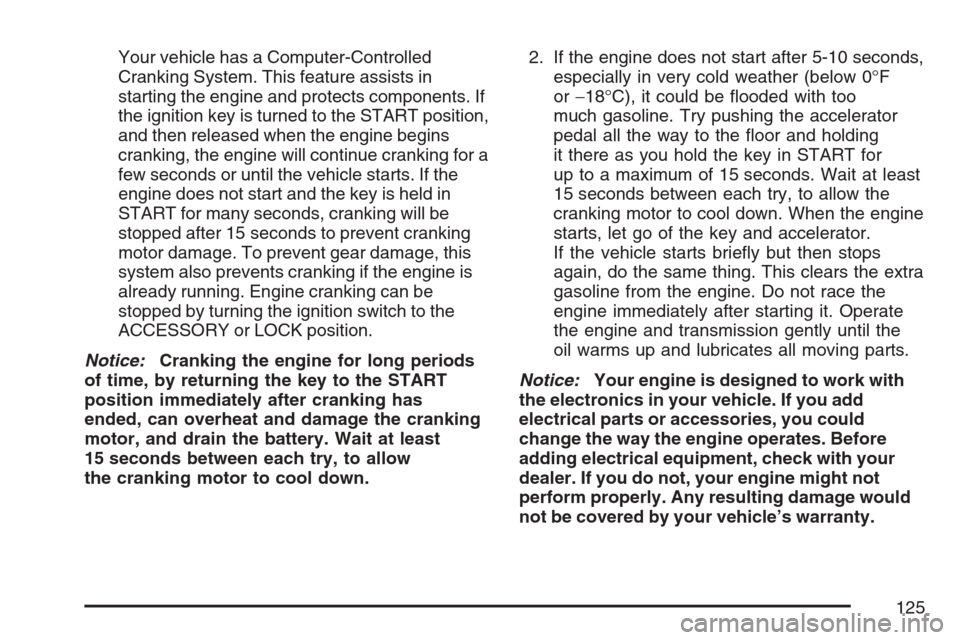
Your vehicle has a Computer-Controlled
Cranking System. This feature assists in
starting the engine and protects components. If
the ignition key is turned to the START position,
and then released when the engine begins
cranking, the engine will continue cranking for a
few seconds or until the vehicle starts. If the
engine does not start and the key is held in
START for many seconds, cranking will be
stopped after 15 seconds to prevent cranking
motor damage. To prevent gear damage, this
system also prevents cranking if the engine is
already running. Engine cranking can be
stopped by turning the ignition switch to the
ACCESSORY or LOCK position.
Notice:Cranking the engine for long periods
of time, by returning the key to the START
position immediately after cranking has
ended, can overheat and damage the cranking
motor, and drain the battery. Wait at least
15 seconds between each try, to allow
the cranking motor to cool down.2. If the engine does not start after 5-10 seconds,
especially in very cold weather (below 0°F
or−18°C), it could be �ooded with too
much gasoline. Try pushing the accelerator
pedal all the way to the �oor and holding
it there as you hold the key in START for
up to a maximum of 15 seconds. Wait at least
15 seconds between each try, to allow the
cranking motor to cool down. When the engine
starts, let go of the key and accelerator.
If the vehicle starts brie�y but then stops
again, do the same thing. This clears the extra
gasoline from the engine. Do not race the
engine immediately after starting it. Operate
the engine and transmission gently until the
oil warms up and lubricates all moving parts.
Notice:Your engine is designed to work with
the electronics in your vehicle. If you add
electrical parts or accessories, you could
change the way the engine operates. Before
adding electrical equipment, check with your
dealer. If you do not, your engine might not
perform properly. Any resulting damage would
not be covered by your vehicle’s warranty.
125
Page 128 of 618
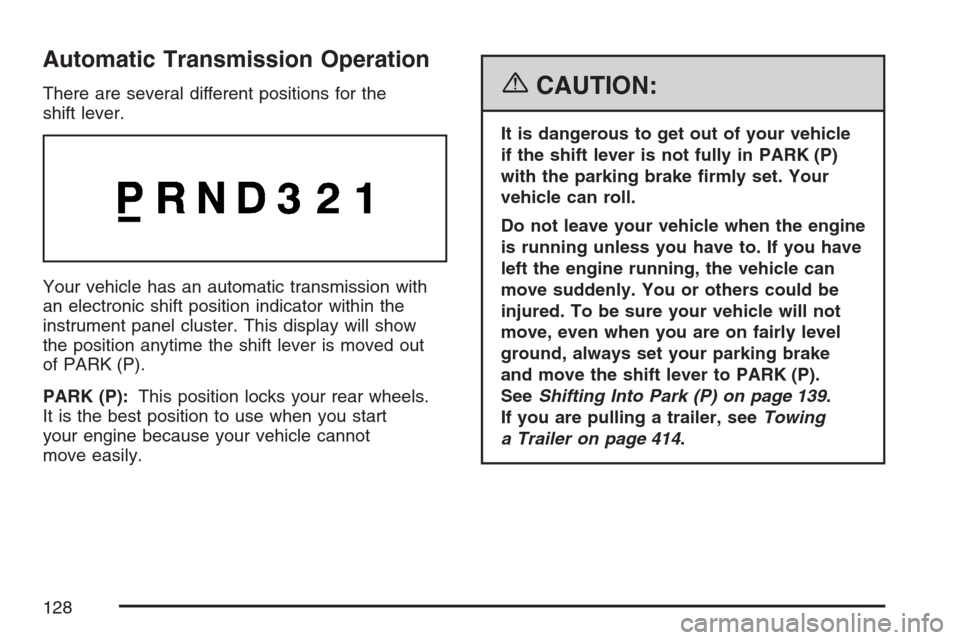
Automatic Transmission Operation
There are several different positions for the
shift lever.
Your vehicle has an automatic transmission with
an electronic shift position indicator within the
instrument panel cluster. This display will show
the position anytime the shift lever is moved out
of PARK (P).
PARK (P):This position locks your rear wheels.
It is the best position to use when you start
your engine because your vehicle cannot
move easily.{CAUTION:
It is dangerous to get out of your vehicle
if the shift lever is not fully in PARK (P)
with the parking brake �rmly set. Your
vehicle can roll.
Do not leave your vehicle when the engine
is running unless you have to. If you have
left the engine running, the vehicle can
move suddenly. You or others could be
injured. To be sure your vehicle will not
move, even when you are on fairly level
ground, always set your parking brake
and move the shift lever to PARK (P).
SeeShifting Into Park (P) on page 139.
If you are pulling a trailer, seeTowing
a Trailer on page 414.
128
Page 129 of 618
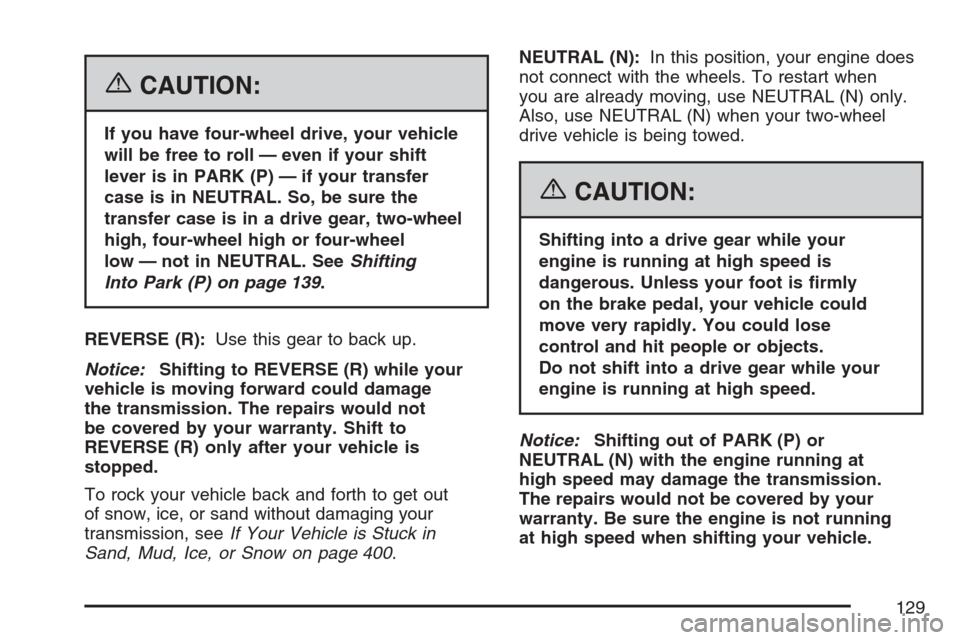
{CAUTION:
If you have four-wheel drive, your vehicle
will be free to roll — even if your shift
lever is in PARK (P) — if your transfer
case is in NEUTRAL. So, be sure the
transfer case is in a drive gear, two-wheel
high, four-wheel high or four-wheel
low — not in NEUTRAL. SeeShifting
Into Park (P) on page 139.
REVERSE (R):Use this gear to back up.
Notice:Shifting to REVERSE (R) while your
vehicle is moving forward could damage
the transmission. The repairs would not
be covered by your warranty. Shift to
REVERSE (R) only after your vehicle is
stopped.
To rock your vehicle back and forth to get out
of snow, ice, or sand without damaging your
transmission, seeIf Your Vehicle is Stuck in
Sand, Mud, Ice, or Snow on page 400.NEUTRAL (N):In this position, your engine does
not connect with the wheels. To restart when
you are already moving, use NEUTRAL (N) only.
Also, use NEUTRAL (N) when your two-wheel
drive vehicle is being towed.
{CAUTION:
Shifting into a drive gear while your
engine is running at high speed is
dangerous. Unless your foot is �rmly
on the brake pedal, your vehicle could
move very rapidly. You could lose
control and hit people or objects.
Do not shift into a drive gear while your
engine is running at high speed.
Notice:Shifting out of PARK (P) or
NEUTRAL (N) with the engine running at
high speed may damage the transmission.
The repairs would not be covered by your
warranty. Be sure the engine is not running
at high speed when shifting your vehicle.
129
Page 130 of 618
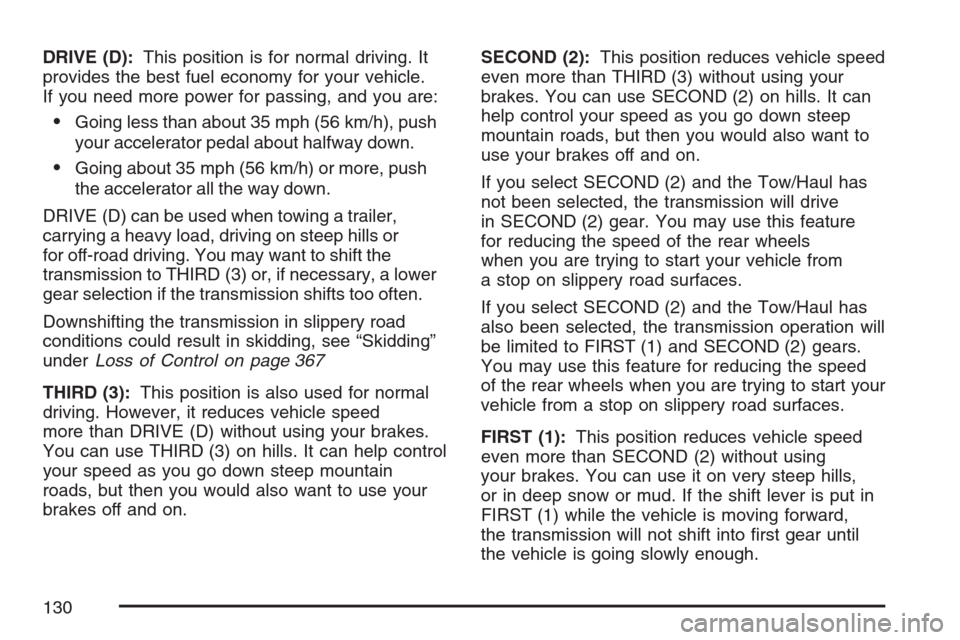
DRIVE (D):This position is for normal driving. It
provides the best fuel economy for your vehicle.
If you need more power for passing, and you are:
Going less than about 35 mph (56 km/h), push
your accelerator pedal about halfway down.
Going about 35 mph (56 km/h) or more, push
the accelerator all the way down.
DRIVE (D) can be used when towing a trailer,
carrying a heavy load, driving on steep hills or
for off-road driving. You may want to shift the
transmission to THIRD (3) or, if necessary, a lower
gear selection if the transmission shifts too often.
Downshifting the transmission in slippery road
conditions could result in skidding, see “Skidding”
underLoss of Control on page 367
THIRD (3):This position is also used for normal
driving. However, it reduces vehicle speed
more than DRIVE (D) without using your brakes.
You can use THIRD (3) on hills. It can help control
your speed as you go down steep mountain
roads, but then you would also want to use your
brakes off and on.SECOND (2):This position reduces vehicle speed
even more than THIRD (3) without using your
brakes. You can use SECOND (2) on hills. It can
help control your speed as you go down steep
mountain roads, but then you would also want to
use your brakes off and on.
If you select SECOND (2) and the Tow/Haul has
not been selected, the transmission will drive
in SECOND (2) gear. You may use this feature
for reducing the speed of the rear wheels
when you are trying to start your vehicle from
a stop on slippery road surfaces.
If you select SECOND (2) and the Tow/Haul has
also been selected, the transmission operation will
be limited to FIRST (1) and SECOND (2) gears.
You may use this feature for reducing the speed
of the rear wheels when you are trying to start your
vehicle from a stop on slippery road surfaces.
FIRST (1):This position reduces vehicle speed
even more than SECOND (2) without using
your brakes. You can use it on very steep hills,
or in deep snow or mud. If the shift lever is put in
FIRST (1) while the vehicle is moving forward,
the transmission will not shift into �rst gear until
the vehicle is going slowly enough.
130
Page 131 of 618
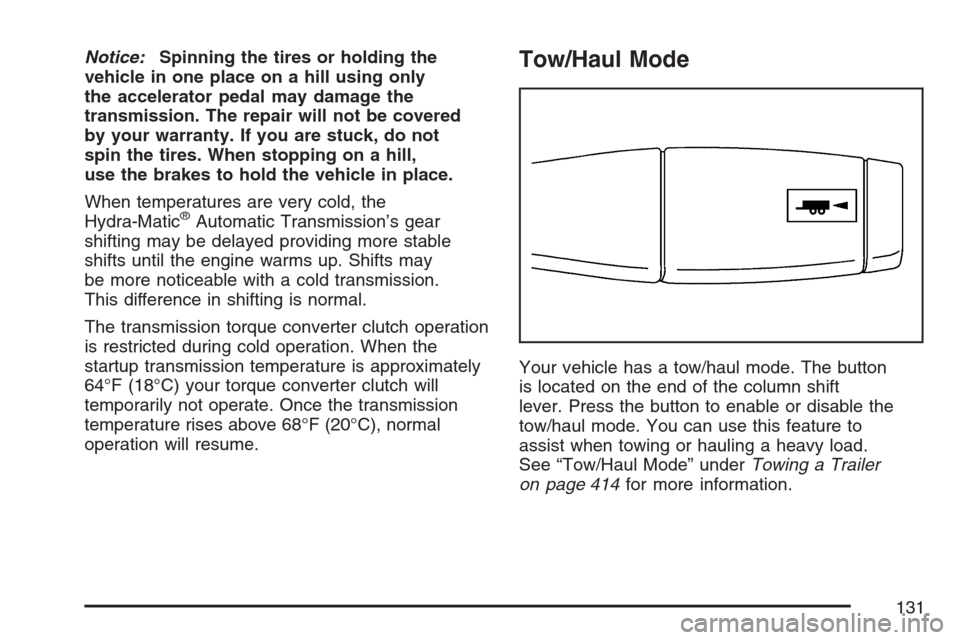
Notice:Spinning the tires or holding the
vehicle in one place on a hill using only
the accelerator pedal may damage the
transmission. The repair will not be covered
by your warranty. If you are stuck, do not
spin the tires. When stopping on a hill,
use the brakes to hold the vehicle in place.
When temperatures are very cold, the
Hydra-Matic
®Automatic Transmission’s gear
shifting may be delayed providing more stable
shifts until the engine warms up. Shifts may
be more noticeable with a cold transmission.
This difference in shifting is normal.
The transmission torque converter clutch operation
is restricted during cold operation. When the
startup transmission temperature is approximately
64°F (18°C) your torque converter clutch will
temporarily not operate. Once the transmission
temperature rises above 68°F (20°C), normal
operation will resume.
Tow/Haul Mode
Your vehicle has a tow/haul mode. The button
is located on the end of the column shift
lever. Press the button to enable or disable the
tow/haul mode. You can use this feature to
assist when towing or hauling a heavy load.
See “Tow/Haul Mode” underTowing a Trailer
on page 414for more information.
131
Page 133 of 618
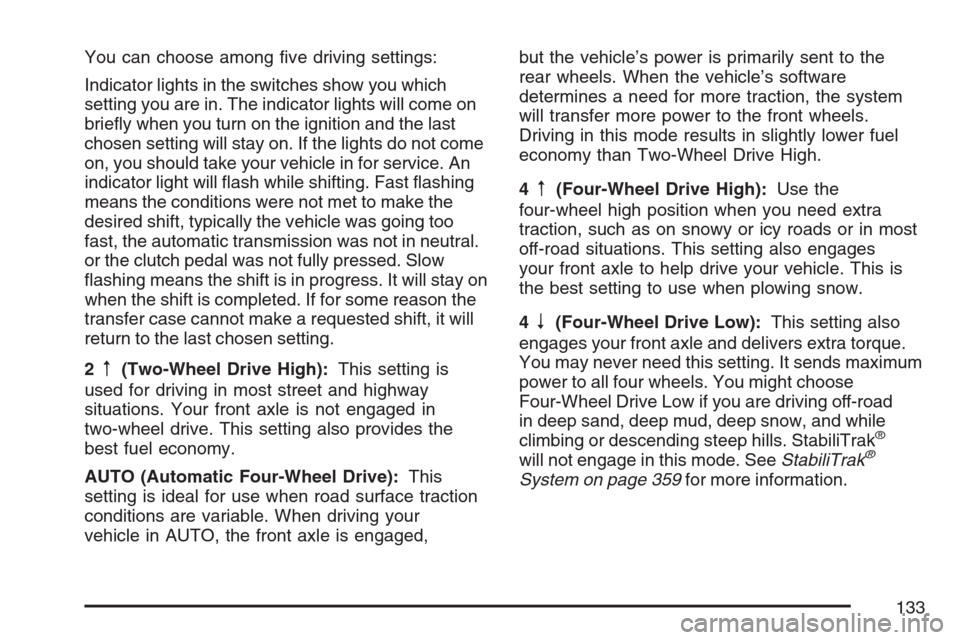
You can choose among �ve driving settings:
Indicator lights in the switches show you which
setting you are in. The indicator lights will come on
brie�y when you turn on the ignition and the last
chosen setting will stay on. If the lights do not come
on, you should take your vehicle in for service. An
indicator light will �ash while shifting. Fast �ashing
means the conditions were not met to make the
desired shift, typically the vehicle was going too
fast, the automatic transmission was not in neutral.
or the clutch pedal was not fully pressed. Slow
�ashing means the shift is in progress. It will stay on
when the shift is completed. If for some reason the
transfer case cannot make a requested shift, it will
return to the last chosen setting.
2
m(Two-Wheel Drive High):This setting is
used for driving in most street and highway
situations. Your front axle is not engaged in
two-wheel drive. This setting also provides the
best fuel economy.
AUTO (Automatic Four-Wheel Drive):This
setting is ideal for use when road surface traction
conditions are variable. When driving your
vehicle in AUTO, the front axle is engaged,but the vehicle’s power is primarily sent to the
rear wheels. When the vehicle’s software
determines a need for more traction, the system
will transfer more power to the front wheels.
Driving in this mode results in slightly lower fuel
economy than Two-Wheel Drive High.
4
m(Four-Wheel Drive High):Use the
four-wheel high position when you need extra
traction, such as on snowy or icy roads or in most
off-road situations. This setting also engages
your front axle to help drive your vehicle. This is
the best setting to use when plowing snow.
4
n(Four-Wheel Drive Low):This setting also
engages your front axle and delivers extra torque.
You may never need this setting. It sends maximum
power to all four wheels. You might choose
Four-Wheel Drive Low if you are driving off-road
in deep sand, deep mud, deep snow, and while
climbing or descending steep hills. StabiliTrak
®
will not engage in this mode. SeeStabiliTrak®
System on page 359for more information.
133
Page 134 of 618
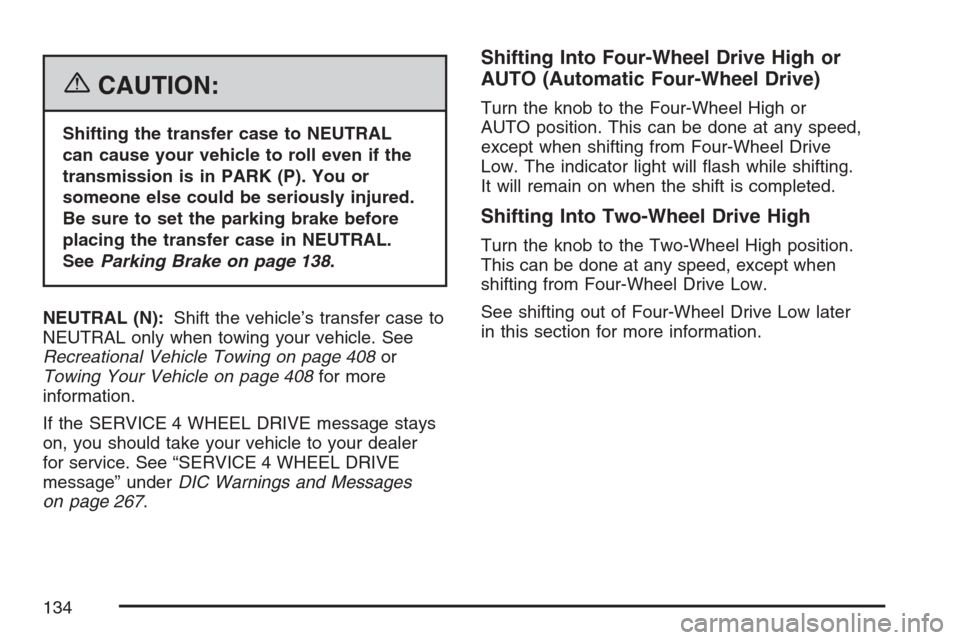
{CAUTION:
Shifting the transfer case to NEUTRAL
can cause your vehicle to roll even if the
transmission is in PARK (P). You or
someone else could be seriously injured.
Be sure to set the parking brake before
placing the transfer case in NEUTRAL.
SeeParking Brake on page 138.
NEUTRAL (N):Shift the vehicle’s transfer case to
NEUTRAL only when towing your vehicle. See
Recreational Vehicle Towing on page 408or
Towing Your Vehicle on page 408for more
information.
If the SERVICE 4 WHEEL DRIVE message stays
on, you should take your vehicle to your dealer
for service. See “SERVICE 4 WHEEL DRIVE
message” underDIC Warnings and Messages
on page 267.
Shifting Into Four-Wheel Drive High or
AUTO (Automatic Four-Wheel Drive)
Turn the knob to the Four-Wheel High or
AUTO position. This can be done at any speed,
except when shifting from Four-Wheel Drive
Low. The indicator light will �ash while shifting.
It will remain on when the shift is completed.
Shifting Into Two-Wheel Drive High
Turn the knob to the Two-Wheel High position.
This can be done at any speed, except when
shifting from Four-Wheel Drive Low.
See shifting out of Four-Wheel Drive Low later
in this section for more information.
134